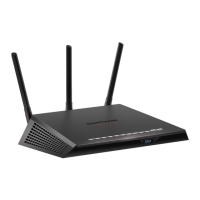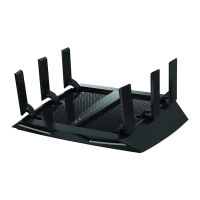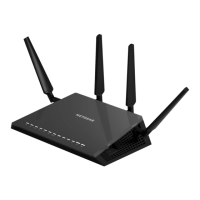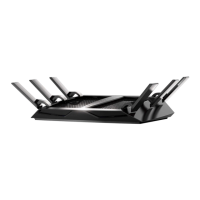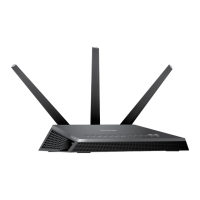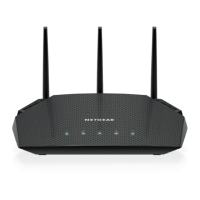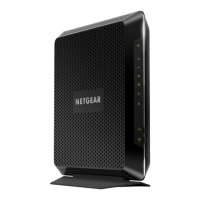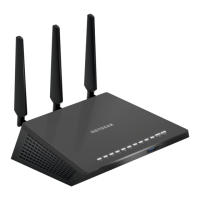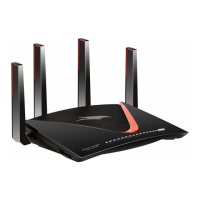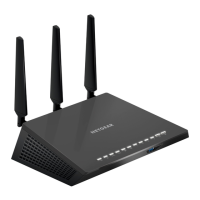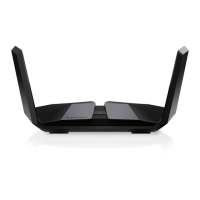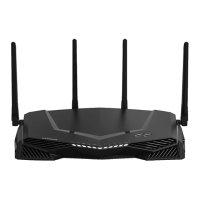
Do you have a question about the NETGEAR XR500 Nighthawk and is the answer not in the manual?
| Brand | NETGEAR |
|---|---|
| Model | XR500 Nighthawk |
| Antennas | 4 external antennas |
| VPN Support | Yes |
| Beamforming | Yes |
| RAM | 512MB |
| Flash Memory | 256MB |
| WiFi Technology | 802.11ac |
| WiFi Speed | AC2600 (800Mbps + 1733Mbps) |
| Processor | Dual Core 1.7GHz |
| Ethernet Ports | 5 x 10/100/1000 Mbps Gigabit Ethernet (1 WAN & 4 LAN) |
| USB Ports | 2 x USB 3.0 |
| QoS | Dynamic QoS |
| Security Features | VPN support |
Details on unpacking the XR500 Nighthawk Pro Gaming Router, antennas, power adapter, and Ethernet cable.
Description of status LEDs, buttons on top panel, and USB 3.0 ports on the left side panel.
Overview of rear panel components including LED On/Off switch, Reset button, antenna connectors, and ports.
Instructions for attaching the four antennas to the router for optimal WiFi performance.
Guidelines for placing the router to maximize WiFi range and take advantage of advanced features.
Steps to connect the router to the modem and power outlet, and turn it on.
How to connect your computer to the router via wired Ethernet or WiFi connection.
Explanation of ISP login, WiFi password, and router login for accessing the web interface.
Instructions on using a web browser to access the router for setup and configuration.
Guide to easily installing the router, updating firmware, and personalizing WiFi via the NETGEAR Up app.
Steps to automatically set up your router by detecting Internet settings using the Setup Wizard.
Guidance on viewing or changing the router's specific Internet connection settings manually.
Steps to set up various IPv6 Internet connection types if the router does not detect it automatically.
Guidance on adjusting the Maximum Transmission Unit (MTU) size for network packet optimization.
Using the Geo Filter to limit game host distance, reducing lag and improving response time.
Allocating bandwidth to specific devices using Quality of Service (QoS) and Anti-Bufferbloat features.
Prioritizing traffic for specific devices to reduce network lag and improve performance.
View all connected devices, change display settings, prevent display, or block devices.
Monitor devices, traffic categories, and applications using upload/download bandwidth.
Access system information including firmware version, CPU usage, RAM, and network status.
Add, remove, rearrange, and resize dashboard panes for a personalized view.
Block keywords, domains, or specific internet sites using content filtering rules.
Add outbound firewall rules to prevent access to specific services and applications.
Create schedules for keyword blocking and outbound firewall rules to define active times.
Set up email alerts for security events and log messages from the router.
Configure wide area network (WAN) settings, including DMZ, MTU size, and NAT filtering.
Configure a default DMZ server for applications incompatible with NAT, with security warnings.
Modify the router's LAN IP address and Router Information Protocol (RIP) settings.
Define the range of IP addresses the router's DHCP server assigns to LAN devices.
Assign static IP addresses to specific devices for consistent network access.
Configure bridging using Port Group or VLAN Tag Group for direct ISP network connection.
Configure WiFi network name (SSID), password, security options, and region settings.
Update the WiFi password and select WPA2-PSK [AES] for strong security.
Create a separate WiFi network for guests, providing Internet access without sharing security keys.
Set up WEP security, a legacy mode limiting WiFi speed to 54 Mbps.
Enable or disable router's WiFi radios via the web interface or the physical WiFi On/Off button.
Check for and install new router firmware to ensure optimal performance and security.
Modify the router's administrative password for secure access to settings.
Back up, restore, or erase router configuration settings to preserve or reset settings.
Set up remote management to access router settings over the Internet securely.
Monitor internet traffic volume, set limits, and view live traffic usage updates.
View and manage router actions, including website access attempts and security events.
Verify the router's WAN Ethernet connection status and view IP address details.
Remotely restart the router using its web interface for troubleshooting or updates.
Requirements for USB devices and steps to connect them to the router's USB ports.
How to access USB storage devices connected to the router from Windows-based computers.
Instructions for accessing USB storage devices connected to the router from Mac computers.
Using ReadySHARE Vault for automatic backup of Windows-based computers.
Using Time Machine to back up Mac computers onto a USB hard drive connected to the router.
Configure workgroup names and access methods (Network Neighborhood, HTTP, HTTPS, FTP) for USB storage.
Set up the router to share only approved USB devices for enhanced security.
Procedure to safely take a USB storage device offline before physically disconnecting it.
Steps to set up a personal FTP server using Dynamic DNS for remote network access.
Guide to getting a free Dynamic DNS account for easier remote network access.
How to access USB storage devices remotely via the Internet using FTP or other methods.
Configure DLNA, TiVo, and iTunes media server functionality for playing media files.
Set up the router's iTunes server to play music from USB storage using iTunes.
Configure the router to allow TiVo devices to access media files stored on a USB device.
Steps for installing the printer driver and connecting the USB printer to the router.
Download the ReadySHARE Printer utility for Windows, Mac, smartphones, and tablets.
Install the NETGEAR USB Control Center utility on computers sharing the printer.
How to print documents using the NETGEAR USB Control Center utility.
Check the status of connected printers (Available, Connected, Manually Connected).
Enabling VPN service in the router for secure remote network access.
Instructions for installing OpenVPN client software on Windows, Mac, iOS, and Android devices.
Opening a VPN tunnel from a Windows computer to the router over the Internet.
Accessing USB storage and media from a Windows computer through a VPN tunnel.
Configure router to allow VPN clients to use home Internet service or block Internet access.
Configure router as a VPN client to securely access external networks.
Enable the router's VPN client and establish a connection to an external VPN server.
Procedure to disconnect the router from the VPN server and terminate the VPN connection.
Allow incoming traffic to a server by setting up port forwarding rules for services.
Add custom port forwarding rules for applications not predefined in the router.
Configure port triggering rules to dynamically open incoming ports for applications.
Temporarily disable port triggering without removing configured services or applications.
Tips for troubleshooting common issues like network restart and cable connections.
Diagnose issues based on the behavior of the router's LED indicators.
Steps to resolve issues when unable to log in to the router's web interface.
Troubleshooting steps when the router is accessible but the Internet connection fails.
Resolve problems with loading web pages, including traffic meter and DNS issues.
Steps to isolate and resolve issues with connecting to the router over WiFi.
Using the ping utility to test network paths and diagnose connectivity problems.
Default router configuration settings including login, network, and firewall parameters.
Detailed technical specifications for the XR500 router, including protocols, power, and wireless standards.
